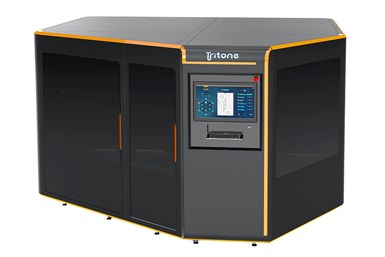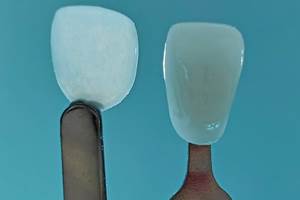MoldJet Technology Enables High-Throughput Metal, Ceramic Additive Manufacturing
Formnext 2023: Tritone Technologies’ additive manufacturing solutions enable industrial throughput of accurate parts with a range of metal and ceramic materials.
Tritone Technologies’ MoldJet, Dominant and Dim technologies for metal and ceramic additive manufacturing (AM) are designed to enable industrial throughput of accurate parts with a range of metal and ceramic materials, suitable for the automotive, aerospace, medical and consumer electronics industries. The technology works with a wide selection of high-performance materials, including copper, stainless steels, titanium, tool steels, high temperature alloys, and ceramic across diverse applications.
MoldJet is a powder-free AM technology that enables production of metal and ceramic parts at industrial scale and speed. It is designed for producing complex geometry parts, with high density and great mechanical properties. The technology enables a quick and easy changeover between a wide variety of metals and ceramics, with parts of different geometries and applications manufactured in the same batch. Operational benefits include a powder-free and hands-free process, labor-free technology, highly robust green parts, a safe industrial environment and more.
The technology features a simultaneous process that produces large quantities of parts per shift utilizing a variety of metal alloys. The system creates fine detail and smooth surface quality with high printing resolution and precision for enabling complex part geometries. Part sizes can range from 2-mm to more than 400-mm parts. An auto layer correction feature enables real-time verification and control of the quality of each layer. Materials are delivered through sealed cartridges — suitable for a clean industrial environment. Robust green parts enable easy transition to sinter without damaging part quality.
The Dominant system utilizes the MoldJet technology for industrial throughput with a simultaneous process that exceeds throughput of 1,600 cc/hr to produce large quantities of parts per shift. The build volume is 400 × 240 × 120 mm (L × W × H) over 6 trays. The machine footprint is 3,200 × 2,200 × 1,900 mm (L × W × H).
The Dim system also offers industrial throughput with simultaneous process with this system exceeding throughput of 220 cc/hr. It features a build volume of 220 × 120 × 90 mm (L × W × H) over 4 trays. The machine footprint is 2,150 × 1960 × 1800 mm (L × W × H).
- Read about Tritone’s collaboration with DSH Technologies to launch the Outsource Sintering Furnace-Access Program. Through the Furnace-Access program, Tritone customers will have immediate access to Elnik sintering furnaces and metallurgy expertise with no upfront capital investment or additional staffing required.
- Learn about APG utilizing Tritone’s MoldJet technology for metal parts production. APG delivers highly engineered powder metal, metal injection molding (MIM) and AM components, serving a diverse customer base with a range of high-performance applications.
Related Content
BMF Receives FDA Clearance for UltraThineer Dental Veneer Material
The zirconia materials are now qualified for use in the production of the world’s thinnest cosmetic veneers, which require significantly less tooth preparation or grinding, thereby preserving more of the patient’s natural enamel.
Read MoreItalian Furniture Maker Uses WASP Technology to Create 3D Printed Pendant Lamps
The versatility of 3D printed ceramic enabled the designers to shape a weave reminiscent of the beehive concept, enhanced by the light source.
Read More3D Systems Develops Multimaterial, One-Piece Jetted Denture Solution
The combination of 3D Systems’ high-speed printing technology with unique materials for the NextDent Jet Denture Teeth and NextDent Jet Denture Base solution is designed to offer superior durability and aesthetics for a better patient experience.
Read MoreVideo: AM for Harder, Longer-Lasting Brake Discs
Additive manufacturing is being applied to limit automotive brake dust. For a major automaker, Etxetar and Talens are developing a production-speed directed energy deposition system to give brake discs a precise layer of wear-resistant carbide.
Read MoreRead Next
Alquist 3D Looks Toward a Carbon-Sequestering Future with 3D Printed Infrastructure
The Colorado startup aims to reduce the carbon footprint of new buildings, homes and city infrastructure with robotic 3D printing and a specialized geopolymer material.
Read MoreBike Manufacturer Uses Additive Manufacturing to Create Lighter, More Complex, Customized Parts
Titanium bike frame manufacturer Hanglun Technology mixes precision casting with 3D printing to create bikes that offer increased speed and reduced turbulence during long-distance rides, offering a smoother, faster and more efficient cycling experience.
Read MorePostprocessing Steps and Costs for Metal 3D Printing
When your metal part is done 3D printing, you just pull it out of the machine and start using it, right? Not exactly.
Read More





















